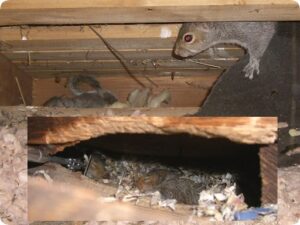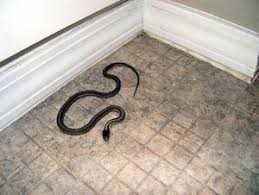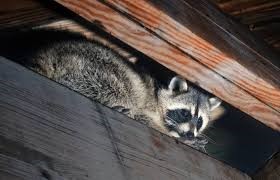Top 11 Tips for Dealing With Nuisance Wildlife Updated June 16th, 2024 Have Nuisance Wildlife in Your Home?

At It Bugs Me Pest Control, we understand that dealing with nuisance wildlife can be a challenging and stressful experience. As experts in humane wildlife removal in Germantown, Tennessee, we are committed to providing professional and effective solutions. These unwelcome guests can cause significant damage to your property and pose health risks to your family. From raccoons rummaging through your trash to skunks leaving a foul odor near your home, addressing wildlife issues promptly is crucial to prevent further damage and ensure the safety of your home. In this article, we provide top tips for dealing with nuisance wildlife, offering humane solutions and expert advice to help you manage and prevent wildlife infestations.
Common Nuisance Wildlife and Their Habitats Nuisance wildlife comes in various forms, each with unique behaviors and preferred habitats. Understanding these animals is the first step in effectively controlling their presence on your property.
- Raccoons: Notorious for their curiosity and dexterity, raccoons often find their way into trash cans, attics, and basements. They are nocturnal and can cause extensive damage in their search for food and shelter. Signs of a raccoon presence include overturned garbage cans, droppings, and scratches on entry points.
- Skunks: Known for their potent spray, skunks typically burrow under porches, decks, and sheds. Signs of their presence include a strong, unpleasant odor, tracks, and holes in the yard where they dig for grubs.
- Rodents: Rats and mice are common pests that can infest homes and properties, known for chewing through wires, insulation, and food storage. Signs include droppings, gnawed materials, and nests made of shredded paper or fabric.
- Squirrels: Agile climbers, squirrels can easily access your attic or chimney, causing damage by chewing on wires, insulation, and wooden structures. Look for nests made of leaves and twigs, droppings, and chewed entry points.
- Bats: Beneficial for controlling insect populations, bats can become a nuisance when they roost in large numbers in your attic or eaves. They can be identified by their droppings, known as guano, and distinctive squeaking sounds.
- Birds: Pigeons, sparrows, and starlings can create problems when they nest in vents, gutters, and rooftops. Their droppings can damage property and create health hazards. Signs include nests in unwanted areas, droppings, and feathers.
Understanding the habits and signs of these common nuisance wildlife species is essential for effective control and removal.
Preventative Measures to Keep Wildlife at Bay Preventing wildlife from entering your property is the most effective way to avoid dealing with nuisance animals. Here are some practical tips to keep wildlife at bay:
- Securing Your Home and Property:
- Seal Entry Points: Inspect your home for potential entry points and seal any gaps or holes, especially around the roof, vents, and foundation.
- Install Chimney Caps and Screens: Prevent animals like birds, bats, and squirrels from entering your home by using chimney caps and vent screens.
- Repair Damaged Screens: Ensure all windows and doors have intact screens. Repair or replace any that are damaged.
- Proper Waste Management and Food Storage:
- Use Animal-Proof Trash Cans: Invest in sturdy, animal-proof trash cans with secure lids to prevent raccoons and other animals from accessing your garbage.
- Store Food Properly: Keep pet food and birdseed in sealed containers and avoid leaving pet food outside overnight.
- Compost Carefully: Use a secure compost bin and avoid adding meat, bones, or dairy products to prevent attracting wildlife.
- Landscaping Tips to Deter Wildlife:
- Trim Overhanging Branches: Keep tree branches trimmed away from your roof to prevent animals like squirrels from accessing your home.
- Remove Attractants: Eliminate sources of food and water in your yard, such as fallen fruit, bird feeders, and standing water.
- Use Plants as Deterrents: Some plants, like marigolds and lavender, can deter certain wildlife due to their strong scents.
- Maintain a Clean Property:
- Clean Up Debris: Regularly remove leaf piles, brush, and other debris where animals may seek shelter.
- Secure Firewood: Store firewood at least 20 feet away from your home and elevate it off the ground to prevent animals from nesting.
By implementing these preventative measures, you can significantly reduce the likelihood of wildlife intruding into your home and property.

Humane Wildlife Removal Techniques
When wildlife finds its way into your home, it’s essential to remove them humanely and safely. Here are some effective techniques for humane wildlife removal:
- Trapping and Relocation:
- Live Traps: Use live traps to capture animals such as raccoons, skunks, and rodents without harming them. Ensure the traps are appropriately sized for the animal you are targeting.
- Relocation: Once captured, relocate the animal at least five miles away from your home to prevent them from returning. Check local regulations for guidelines on relocating wildlife.
- Exclusion Methods and Deterrents:
- One-Way Doors: Install one-way doors at entry points to allow animals to exit your home but prevent them from re-entering. This method is effective for animals like bats and squirrels.
- Repellents: Use natural or commercial repellents to deter animals. For example, ammonia-soaked rags can repel raccoons, while peppermint oil can deter rodents.
- Noise and Light: Use noise machines or bright lights in attics or crawl spaces to encourage nocturnal animals to leave.
- Professional Wildlife Removal Services:
- Hiring Experts: Consider hiring It Bugs Me Pest Control for professional wildlife removal services, especially for larger animals or complex infestations. Our team has the tools and knowledge to handle wildlife safely and humanely.
- Follow-Up Services: We offer follow-up inspections and preventative measures to ensure the animals do not return.
- Handling Injured or Orphaned Wildlife:
- Contact Wildlife Rehabilitators: If you encounter injured or orphaned wildlife, contact a local wildlife rehabilitator for assistance. They can provide the necessary care and rehabilitation for the animals.
- Avoid Handling: Do not attempt to handle injured or orphaned wildlife yourself, as this can be dangerous for both you and the animal.
Using these humane wildlife removal techniques ensures the safety and well-being of both the animals and your household.

Long-Term Wildlife Management Strategies After removing nuisance wildlife from your property, it’s essential to implement long-term strategies to prevent future infestations. Here are some effective long-term wildlife management strategies:
- Ongoing Maintenance and Monitoring:
- Regular Inspections: Conduct regular inspections of your home and property to identify potential entry points and signs of wildlife activity.
- Maintain Seals and Screens: Ensure all previously sealed entry points and screen
